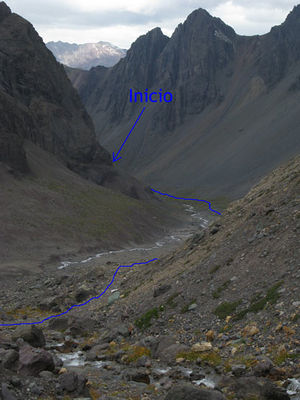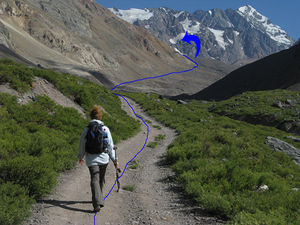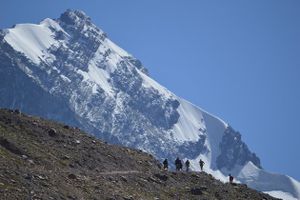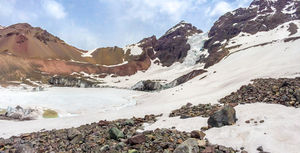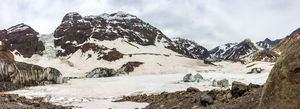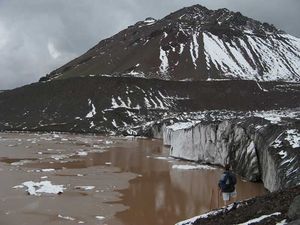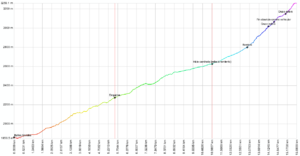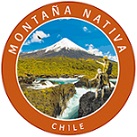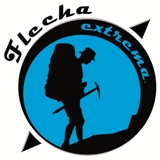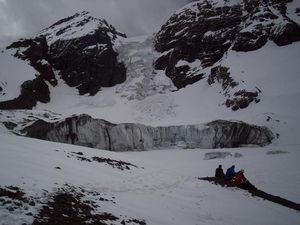Diferencia entre revisiones de «ENG:Glaciar del Morado»
(→Descripción del área) |
(→Geography) |
||
| Línea 114: | Línea 114: | ||
=== Geography === | === Geography === | ||
| − | This area presents two types of climate: A temperate one with a long dry season | + | This area presents two types of climate: A temperate one with a long dry season and an ice one due to the effects of the altitude. The average annual temperature is 13ºC, and the annual average rainfall reaches 600mm. Humidity is over 40% for most of the year. |
| − | The Arenas Valley belongs to what is called "Cuenca Superior Río Volcán" (High Basin of the Volcan River), making it one of the main tributaries of the Volcan river, along with the sub-basin of La Engorda river. The flowrates occur during the months of November and March, due to the rising temperatures. During the winter months, the flowrate is markedly decreased | + | The Arenas Valley belongs to what is called "Cuenca Superior Río Volcán" (High Basin of the Volcan River), making it one of the main tributaries of the Volcan river, along with the sub-basin of La Engorda river. The highest flowrates occur during the months of November and March, due to the rising temperatures. During the winter months, the flowrate is markedly decreased. |
| − | + | ||
| − | + | ||
| + | |||
| + | Geomorphologically speaking, high mountain morphogenetics take place here, where erosive processes dominate and work to transport material and wear out the hillsides. | ||
En relación a la geomorfología, se identifican el tipo morfogenéticos “alta montaña” en donde operan en forma dominante procesos erosivos, de desgaste de las laderas y de transporte de los materiales. | En relación a la geomorfología, se identifican el tipo morfogenéticos “alta montaña” en donde operan en forma dominante procesos erosivos, de desgaste de las laderas y de transporte de los materiales. | ||
Revisión del 17:54 11 oct 2016

|
|
|
| |||||||||||||||||||||||||||||||||||||||||||||||||||||||||
 ATENCIÓN: No cometer el error habitual de confundir esta ruta con el trek al Glaciar San Francisco y la Laguna de Morales (a veces mal llamada Laguna del Morado), ubicado en el Monumento Natural el Morado ATENCIÓN: No cometer el error habitual de confundir esta ruta con el trek al Glaciar San Francisco y la Laguna de Morales (a veces mal llamada Laguna del Morado), ubicado en el Monumento Natural el Morado
|
When to visit
- Trekking:From October to May. During October and November there could be a considerable amount of snow to hinder the hike and make it impossible to reach the end of the road by car, but this will be rewarded with an even more beautiful landscape than in the summer months.
- Ski Touring: Between June and mid-October. Keep in mind that starting mid-August it might be necessary to carry your skis on first stretch. On the other hand, in mid-winter the car path is cut at Lo Valdés mining facilities, so you might have to start at Baños Morales.
Acess by Car and Road Condition
From Santiago you must take the G-25 to “Cajón del Maipo.” From the intersection at “Vizcachas” (0 km), its 47 kilometers of pavemented road until you reach the police control in “San Gabriel” (phones +56228611008 y +56228612290, in case you want to confirm the conditions of the road farther ahead, although the answers tend to be excessively “conservative”
The detour at “Baños Morales” the mountain village located at the north side of the “Volcán” river is found at the 65.1km mark (the pavement ends at 66.3 kilometers just before the plaster mine of “Lo Valdés.” between june and september this route may not be in the right conditions in there has been recent snow. If this is the case you must take the road to the left, cross the river and ascend a rough but brief uphill road to the village. Once there, you must park (the bus parking lot is a recommended place) and walk to CONAF, located west of the village crossing the creek.
After 1,6 kilometers from the fork at Baños Morales, the paved road ends and you will pass Lo Valdés mining facilities, where there is some accumulation from the gypsum mine. Six kilometers further from the fork to Banos Morales, and after the "Cuesta de los Afligidos" hill, you will reach a bridge that crosses the Colina river. Just 120 meters after this bridge you will reach "Cabrerío" (ver foto del lugar), to the left of the main path.
"Cabrerío" consists of basically a shelter that is frequented by herders. You can recognize it by a large rock with a small chimney on the top. Here is where the main road is abandoned by turning left on the fork in front of "Cabrerío" to venture into the Arenas mountain valley (set the kilometer marker to zero at this point).
This new dirt road (marked blue on the map) is kept by Alto Maipo hydroelectric power station, and is in excellent condition and good for any vehicle.
The power station has closed the old road on their work area, but has opened a new one that goes further up. On kilometer 6,5 it joins with the old road and reaches a nice plateau, popularly known as "El Choriboulder" due to the large amount of climbing boulders in the area, and a bouldering event that took place here in 2004.
When the road begins to separate from the valley and ascend on the hillside (kilometer 8,05 from Cabrerio), find a wide space to park and begin the hike.
If you drive a 4x4 you can continue for two more kilometers on the old road in very bad condition. The drive here is almost at walking pace, so the usefulness of this road is debatable.
Access by Public Transportation and Autostop
Plantilla:Public transportation Cajon del Maipo
If you take the bus to Banos Morales, there are good chances to make the autostop up to Cabrerio. Getting an autostop from Cabrerio to the parking space (red route) is harder but possible, especially during the summer weekends. If you decide to take the bus and you don't want to try autostop, walk the yellow route.
Route Description
Having parked the car, abandon the main route to take a car path in bad condition, that will become progressively in very bad condition. On the first two kilometers, the path will go by the back of the valley on the west side of the river, where it will slowly gain altitude. At 2.805 AMSL you will pass next to a flag.
Afterwards, the path will begin to distance itself from the main river of the valley, each time higher on the mountain hillside. The slope becomes considerably steeper than on the first stretch of the trek. You will have to continuously cross small creeks on the path. The route is always visible since most of it takes place on the old car path.
You will then have to cross a creek (3.039 AMSL) that comes from the northeast and ascend it on its east side (right side). This is the steepest stretch.
After having crossed the small creek, at 3,079 AMSL, you will reach the absolute end of the car path (Sidenote: In March of 2013 it was still possible to reach this point by car). Reaching this point by car is very difficult and risky: on the highest stretch this old car path is nothing more than aprint with big loose rocks). (ver foto del lugar hasta donde se puede llegar en vehículo 4x4)
Although the start of the walking path is noticeable, this area is covered in snow during the beginning of the summer. ver imagen The lagoon is located in a cirque that forms to the west of this valley, so you must walk in that direction.
You will then reach a flatter area, always on the right side of the creek, which you will here cross for a second time at 3.150 AMSL and then go up the last moraine, where the incline gets steeper. The path does not face the slope directly to the west, but in an oblique line to the northeast. Right at the end of the ascent you will be rewarded by a spectacular panoramic view of El Morado hanging glaciar Cerro Morado, its adjacent glaciers, and its lagoon with ice floes.
Return on the same route
Baños Morales Stretch - Main Route Junction (for ski touring or public transportation)
If upon reaching Lo Valdés gypsum mine the path is closed (which is likely to be the case between June and September) you will have to return and take the detour to Baños Morales, and advance on Volcán's north river side. It is 5,6 kilometres along the yellow route, on an old car path - good for skying - up to the junction with the path that starts at Cabrerio, ascending from 1860 AMSL to 2275 AMSL. This should take a little less than two hours. From this junction, it's 5,4 more kilometres along the blue route to the beginning described on the previous section and that can be reached by car when there's no snow. This stretch entails and ascent from 2275 meters to 2628 meters, which should take another 1.5 hour or so.
360° Virtual Panorama of El Morado Lagoon
Imagen obtenida desde el centro de la Laguna del Morado a mediados de octubre 2014
Estimated Duration
At a normal pace and finishing the route, the hike should consist of 3 hours going up and 2,5 hours back down. Add an extra hour if you are starting from "choriboulders" area.
Permits / Fees
- From 2015, you need a permit to take a car through the valley. It can be requested by writing to vallelasarenas@gmail.com and informing the participants' names and license plate. This permit is free.
- Phone numbers: +56229852609, +56997829336
- Entry is until 4:00pm and exit until 8:00pm.
- These lands belong to Parque Natural Privado Valle Las Arenas
Hiring Guides
Hiring guides is possible for this trek:
Montaña Nativa: Tailored tours, 2 day treks, hot springs, Glaciers, ascents and road trips. Experienced guide with a degree from Escuela Nacional de Andinismo Chileno and ornithology. Ethical and ecological vision. TripAdvisor certificate of excellence 2015.- Contact: guia@montananativa.com
- Phone: +569 6477 8461
- Social Media: Facebook Montaña Nativa
- Ecotrekking Santiago de Chile Ecotourism and "High Mountain" activities in Cajón del Maipo and Farellones. Logistics, guides, and passenger transport.
- Contact: ecotrekkingchile@gmail.com
- Facebook: Ecotrekking Santiago de Chile
- TripAdvisor: Ecotrekking Chile
- Phone: +56966028918 (WhatsApp)
- Ecochile Travel: Regular and private trekking trips in the Andes.
- Contact: info@ecochile.travel, (56- 02) 25708826
- Flecha Extrema: Private Hiking Tours / "High Mountain" Expeditions around Santiago - Experience the Andes
- Contact: contacto@flechaextrema.com, +56 9 65 61 72 77
- Facebook Turismo Flecha Extrema
- Phone: +56965617277 (Whatsapp)
- AndesBrown: Hikes and excursions in Chile's central mountains. Guided tours, certified guides
- Phone +56988382014.
- Cajonoutdoor: Treking, horse back, and excursions in all of Cajón del Maipo. Passenger transport to and from the hotel/airport/chosen destiny. Bilingual local guides.
- Contact: contacto@cajonoutdoor.cl
- Phone: +56991940429 - +56975275503.
Hiring horses and/or mules
Roberto Molina and Katerina Cáceres offer horses and mules, departing from Baños Morales: +56287100051, +56991667566. Consider about CLP$15000 (US$ 15.6 as of November 2024) per day per horse.
Weather Report
Galería de fotos
Glaciar del Morado visto desde la ruta de ascenso al Cerro Arenas. La laguna aparece congelada al pie del glaciar, pero se observan las orillas iniciando el deshielo. Noviembre de 2012
Area Description
This information was obtained directly from Parque Natural Privado Valle Las Arenas and translated
Geography
This area presents two types of climate: A temperate one with a long dry season and an ice one due to the effects of the altitude. The average annual temperature is 13ºC, and the annual average rainfall reaches 600mm. Humidity is over 40% for most of the year. The Arenas Valley belongs to what is called "Cuenca Superior Río Volcán" (High Basin of the Volcan River), making it one of the main tributaries of the Volcan river, along with the sub-basin of La Engorda river. The highest flowrates occur during the months of November and March, due to the rising temperatures. During the winter months, the flowrate is markedly decreased.
Geomorphologically speaking, high mountain morphogenetics take place here, where erosive processes dominate and work to transport material and wear out the hillsides.
En relación a la geomorfología, se identifican el tipo morfogenéticos “alta montaña” en donde operan en forma dominante procesos erosivos, de desgaste de las laderas y de transporte de los materiales.
Flora y fauna
En relación a la flora predominan arbustos bajos de no más de 50 cm de altura, que alternan con las gramíneas en champas, con hojas duras. En zonas húmedas, en tanto, predominan las hierbas perennes. Destacan especies nativas con presencia de alóctonas asilvestradas. Existe la presencia del Matorral Esclerófilo Andino y en el sector alto andino (Río Volcán) se desarrolla la formación de la Estepa Alto-andina de la Cordillera de Santiago. Existe un total de 2 especies amenazadas en el sector altoandino del Río Volcán: Laretia acaulis (Llareta de Santiago) y Alstroemeria exerens (Liuto de cordillera).
En la zona se registra un total de 86 especies, tres anfibios, nueve reptiles, 70 especies de aves de las cuales nueve corresponden a aves rapaces, 10 a aves acuáticas y 51 a aves no rapaces; cuatro especies corresponden a mamíferos. En el sector Estero el Morado existen alrededor de 16 especies en categoría de conservación, siendo la mayoría de la clase reptiles, seguido de los anfibios, mamíferos y aves. Sólo dos de ellas se encuentra en categoría en Peligro (Cururo y Sapito cuatro ojos), 8 son Vulnerables (dos anfibios, cuatro reptiles, un ave rapaz y un ave no rapaz), 4 son Raras (tres reptiles y un ave rapaz), una Inadecuadamente Conocida (el zorro culpeo) y una Fuera de Peligro (la lagartija oscura).
A fines de 2007 el geólogo Christian Salazar Soto y el profesor Dr. Wolfgang Stinnesbeck (geólogo y paleontólogo), ambos de la Universidad de Heidelber de Alemania, descubrieron fósiles de alrededor de 150 a 155 millones de años de antigüedad.






